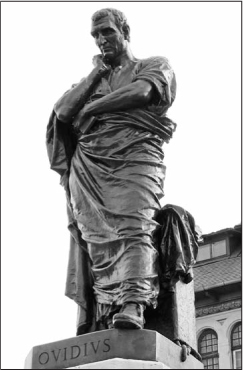Roman MythologyOvid and the Metamorphoses |
What was the Metamorphoses? |
Ovid’s fifteen books of mythological transformations, the Metamorphoses, contains some 250 myths and presents an overview of mythological “history” from the creation to the deification of Julius Caesar. As the Caesar myth indicates, the book is clearly a Roman-inspired work, and Ovid’s knowledge of mythology included Italic traditions, especially as contained in the works of Virgil. But his primary sources were myths told earlier by the Greeks, especially Homer, Hesiod, Aeschylus, Sophocles, Euripides, and Apollodorus. Ovid’s great contribution is the lively, artful, and innovative retelling and embellishing of the old stories. He arranges them in an epic-like continuous form and in so doing maintains a darkly comic and ironic tone rather than a tragic one.

This 1887 statue of the Roman poet Ovid by Ettore Ferrari is displayed in the city of Constanta, which was Tomis, the city of Ovid’s exile.
